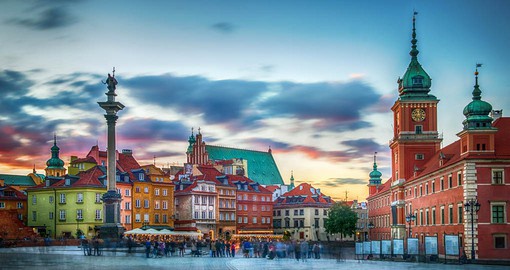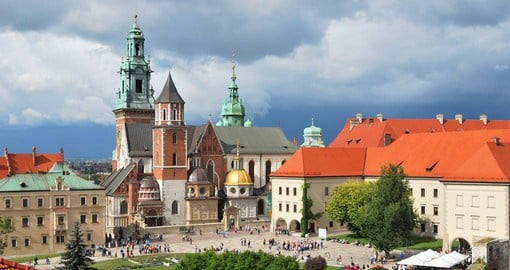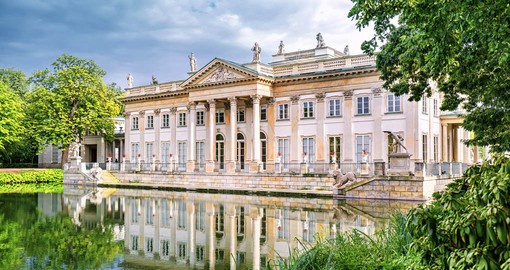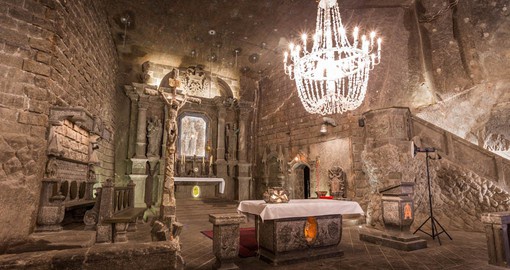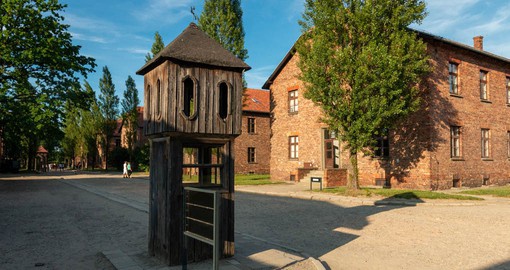Warsaw and Krakow Signature
- Duration
- 10 Days
- Prices From:
- US$ 2,986
DELUXE | PRIVATE-GUIDED: Explore two of Poland’s finest cities on this privately-guided journey to Warsaw and Krakow. Get to know Warsaw’s reconstructed old town and see Wilanow Palace and Lazienki Park, before heading to Krakow to tour Wawel Castle, visit the nearby Wieliczka Salt Mine, and pay respects at Auschwitz-Birkenau.
This 10-day Polish vacation takes you to Warsaw and Krakow to explore Poland’s most famous cities. It features deluxe accommodations, private tours, and is a great introduction to the country.
Your journey begins in Warsaw, the Polish capital that was almost completely rebuilt following the destruction of World War II. You’ll have a few days in Warsaw to see its many historical landmarks and appreciate its varied cultural influences. One day, head on a private city tour starting at the Palace of Culture and Science, a brutalist building leftover from the days of Soviet control, continuing to the Old Town, which was painstakingly rebuilt to capture its medieval past, and finally to the Royal Castle, where the former kings of Poland used to govern the nation.
The next day, enjoy a private tour of Wilanow Palace, located about 10km south of the city centre and one of Poland’s remaining Baroque royal residences. This opulent property has changed hands many times and bears the influences of its many historical owners in its resemblance to a Parisian mansion, Italian garden, and Polish estate manor. On your final day in Warsaw, go on a private tour of the Royal Lazienki Park and Garden Palace, the summer residence of Stanislaw August, the last King of Poland. These 76ha of land contain stunning themes and variations, with notable buildings such as Myslewicki Palace, one of the last classicist-style buildings left in Warsaw.
Head to the train station and ride the train to Krakow, Poland’s tourist centre and one of the most beautiful small cities in Europe. A private city tour will showcase the appeal of its city centre, starting in the Market Square, which is one of Europe’s largest and home to the massive Cloth Hall and St. Mary’s Cathedral, which is decorated with startling colours on the inside. Continue up Wawel Hill to explore Wawel Castle, which overlooks the river and is the unofficial centre of the city. The next day, head to nearby Oswiecim for a sombre tour of the Auschwitz-Birkenau Concentration Camp, learning about the Holocaust and how this beautiful Polish town was transformed into one of the darkest places in human history. Cap off your time in Krakow with a private tour of Wieliczka Salt Mine, located only 25 minutes outside of the city. This salt mine dates back to the 13th century and was the oldest operating salt mine in the world when it ceased production in 1996. Explore the massive subterranean installation, admiring the giant wooden pillars holding up the mine and the fascinating spots such as an entire church sanctuary carved from the salt. At the end of your stay, you’ll head back to the airport to connect back home.
- Duration
- 10 Days
- Prices From:
- US$ 2,986
Itinerary View Trip Map
Warsaw Airport to Warsaw Hotel with Meet and Greet
| Duration | 20 Minutes |
|---|
Mamaison Hotel Le Regina Warsaw
Mamaison Hotel Le Regina Warsaw is a 5-star establishment, located in the heart of Warsaw's New City, a neighbourhood dating from the 15th century in Warsaw, just north of the beautiful Old Town. The newly-build boulevards along the Vistula River are just 800 ft from the hotel, while other landmarks such as the Presidential Palace, the University of Warsaw, as well as the POLIN Museum of the History of Polish Jews are all within walking distance. It's a stylish boutique hotel housed inside Mokrowsky Palace, a building that itself is a popular city attraction. The property is a wonderful mix of historic building with airy and contemporary public spaces. All rooms are elegantly furnished, offering all modern amenities. A perfect place for travellers looking for luxury in the heart of the city.
| Meal Plan | Buffet Breakfast |
|---|---|
| Duration | 4 Nights |
| Accommodation |
Mamaison Hotel Le Regina Warsaw |
| Location | View map |
-
Mamaison Hotel Le Regina Warsaw
Mamaison Hotel Le Regina Warsaw is a 5-star establishment, located in the heart of Warsaw's New City, a neighbourhood dating from the 15th century in Warsaw, just north of the beautiful Old Town. The newly-build boulevards along the Vistula River are just 800 ft from …
Mamaison Hotel Le Regina Warsaw is a 5-star establishment, located in the heart of Warsaw's New City, a neighbourhood dating from the 15th century in Warsaw, just north of the beautiful Old Town. The newly-build boulevards along the Vistula River are just 800 ft from the hotel, while other landmarks such as the Presidential Palace, the University of Warsaw, as well as the POLIN Museum of the History of Polish Jews are all within walking distance. It's a stylish boutique hotel housed inside Mokrowsky Palace, a building that itself is a popular city attraction. The property is a wonderful mix of historic building with airy and contemporary public spaces. All rooms are elegantly furnished, offering all modern amenities. A perfect place for travellers looking for luxury in the heart of the city.
Facilities
- Accessible Facilities
- Air Conditioning
- Free WiFi
- Indoor Pool
- Laundry Service
- Parking
Photo gallery
Photo 1 of 1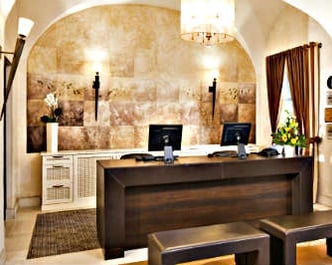
City Tour with Royal Castle
Enjoy an enlightening, privately guided tour of Warsaw, Poland's capital and the country's commercial center. A city with a stormy history, it felt the touch of Napoleon who officially created the Duchy of Warsaw on his way to Moscow, lived through national uprisings and tsarist repressions, and barely survived the Second World War. All these events left their individual imprints on the city. This includes the towering Palace of Culture and Science, a Stalinist behemoth built by Soviet architect Lev Rudnev, and a stark reminder of Warsaw's days under communist rule. Today, it is occupied by rather more sociable institutions such as two museums, a university, four theatres, a multiplex cinema, and a swimming pool. The city's Old Town, dating back to the 13th century, was almost entirely destroyed during WWII but has been meticulously reconstructed and is on the UNESCO World Heritage List. Here, everywhere you go, are evocations of Warsaw's tempestuous past, as much as its reconstruction. Without abandoning its past, today's Old Town has also ushered in an exciting new era. It's a bustling hub with cobblestone alleys and medieval buildings, at the heart of which is the Old Town Market Place, a busy square lined with burgher houses, boutiques, bars, and upscale Polish eateries. Nearby, St. John's Arch cathedral dates to the 14th century and hosts all kinds of concerts during the summer while next to the manicured gardens of the Royal Castle, there are now many restored contemporary apartment buildings. The city's contemporary, creative and even quirky side has, quite naturally, led to the development of trendy neighborhoods, of which Praga, across from the historic center on the other side of the Vistula is, probably, the most popular. On a more curious note, outside some of downtown's subway stations and next to pedestrian crossings, street-sellers have established a thriving business selling, guess what, doughnuts. Your private guide can elaborate on many of the historical and current topics. One of the most fascinating stories is how Varsovians, the name for residents of Warsaw, reconstructed their city. Partially this was done based on cityscapes by the Venetian painter Bernardo Belloto, the nephew of the more famous Canaletto. Belloto had been appointed a court painter to the King of Poland and created very accurate scenes of Warsaw's buildings and squares in 1768. Since 1984 they have been exhibited in the Royal Castle's Canaletto room, which you will visit during your tour. During today's sightseeing, you'll also see the famous site of a row of buildings, cut in half by the war, near the former ghetto and the Presidential Palace where the Warsaw Pact was signed in 1955. The drive along the Royal Route culminates with a visit of the Royal Castle, once the residence of the Polish kings, seat of the Senate and the place where the Polish Constitution was signed.
| Duration | 4 Hours |
|---|
Tour to Wilanow Palace
It's easy to see Warsaw's history only within the confines of WWII and its post-war communist era. During this privately guided tour of Wilanow Palace, just 10 km south of the city center, you'll discover that the city was at some stage the center of the burgeoning Polish-Lithuanian Commonwealth, a union which lasted over 200 years and whose territory at once stretched from the Baltic to the Black Sea. The history of the palace, a wonderful Baroque royal residence, began in 1677 when King John Sobieski III acquired a small village outside Warsaw and decided to build a small abode. In fact, the King's court architect was asked to only create a ground floor residence in the typical layout for ordinary buildings. Military success and the increased importance of his royal status, however, had a huge influence on the remarkable expansion of the original plans. The military success took place near Vienna, which had been under siege for two months, on September 12, 1683. On that day, the Habsburg Monarchy, the Polish-Lithuanian Commonwealth and the Holy Roman Empire fought a decisive battle against Ottoman forces besieging the city and won, which proved to be a remarkable turning point in history. The overall commander of the victorious forces was no other than King John III Sobieski, who now looked at his Wilanow real estate in a very different light. Over the centuries, the property changed hands many times, each new owner adding bits and pieces in their own style, but also experiencing the ups and downs of maintaining what had turned into a sprawling, 45-hectare setting, proudly bearing the moniker of the 'Polish Versailles'. Architecturally speaking, the Baroque palace is a combination of sub-Parisian Versailles, an Italian garden villa and a typical Polish estate manor. The park spreading out around the palace represents different styles: there are a bi-level Baroque Italian garden and a romantic English Chinese park. The fascinating part is that all of this survived almost unchanged since the 17th century, despite WWII creating havoc in the city. In 1805 one of Poland's first museums opened in the palace and you'll be able to visit the main floor with all the royal apartments and the first floor, housing the Gallery of the Polish Portrait, showcasing effigies of Polish monarchs collected over the centuries. Incidentally, the palace does have a second floor, but its restoration won't be completed until 2020. The buildings of the former coach house and manege are, today, used by the Poster Museum, the world's largest institution of its kind with, currently, over 60,000 Polish and International selections. (Entrance to the museum is not included). This is a great, half-day excursion for couples of all ages interested in history, art, and architecture.
| Duration | 4 Hours |
|---|
Tour to Lazienki Park
Enjoy a privately guided excursion around one of the most beautiful palace and park complexes in Europe, a place some people refer to as the happiest place in Warsaw. The Royal Lazienki Palace and Garden complex was the summer residence of Stanislaw August, the last King of Poland. Covering an area of 76 hectares, its present composition dates to 1764 after the King commissioned several painters and architects, some of whom were Italian, to create a Royal Summer Residence. Creating landscaped parks was then very popular in Europe and Warsaw features quite a few, with Lazienki being the largest and most striking. One of its delightful features is the constantly changing scenes and themes, going from naturally forested areas to very elaborate flower and plant arrangements, as well as showcasing edifices and monuments derived from different countries and historical times. The Amphitheatre, for example, reminds one of the theatres in the Herculaneum while the magnificent Palace on the Island, designed by Tylman Gamerski, mixes Corinthian columns with extravagant Baroque styles. The palace, stripped, ruined, and almost blown up after the Warsaw Uprising in 1944 was, eventually, rebuilt and restored after the war. During your visit, you can see some of its lavish interiors, including the marvelous White Room. Be prepared to meet the odd peacock strutting around the Palace and the Theatre, as this area has become their own little sanctuary. Other remarkable buildings around the park include the Old Orangery with the fabulously restored Kamsetzer Colonnade displaying copies of sculptures standing against background paintings of an idyllic Italian landscape. The Myslewicki Palace, meanwhile, is one of the few samples of buildings in the early classicist style that are left in Warsaw. The shape of its roof was designed to resemble patterns found in the traditional style of Chinese art, adding an interesting cultural twist. An important point to remember is that this spectacular park is just a stone's throw from the city center. Lovers of parks, gardens, art and historical palaces will find this a most pleasurable half-day excursion.
| Duration | 4 Hours |
|---|
Warsaw Hotel to Warsaw Train Station
| Duration | 10 Minutes |
|---|
Krakow Train Station to Krakow Hotel
| Duration | 15 Minutes |
|---|
Hotel Copernicus
Hotel Copernicus stands on Kanonicza Street, Krakow's oldest street that winds its way toward Wawel Royal Castle - the historic seat of Polish kings. Amidst the neighbouring Renaissance townhouses Copernicus stands out with its expansive, Gothic facade. As the first in Poland he joined the to Relais & Chateaux -- the exclusive French hotel association.
| Meal Plan | Full Breakfast |
|---|---|
| Duration | 5 Nights |
| Accommodation |
Hotel Copernicus |
| Location | View map |
-
Hotel Copernicus
Hotel Copernicus stands on Kanonicza Street, Krakow's oldest street that winds its way toward Wawel Royal Castle - the historic seat of Polish kings. Amidst the neighbouring Renaissance townhouses Copernicus stands out with its expansive, Gothic facade. As the first in Poland he joined the …
Hotel Copernicus stands on Kanonicza Street, Krakow's oldest street that winds its way toward Wawel Royal Castle - the historic seat of Polish kings. Amidst the neighbouring Renaissance townhouses Copernicus stands out with its expansive, Gothic facade. As the first in Poland he joined the to Relais & Chateaux -- the exclusive French hotel association.
Facilities
- Conference Room
- Restaurant
Photo gallery
Photo 1 of 1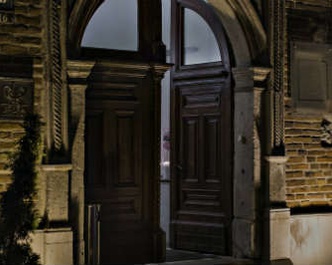
City Tour with Wawel Castle
Poland's former capital is, beyond question, one of the most beautiful cities in Europe. On this privately guided tour, you'll experience many of its highlights after meeting your guide in the lobby of your hotel. A UNESCO World Heritage site since 1978, it is often compared to other medieval Central European cities but has always had a flair uniquely its own, combining a little bit of Gothic, Renaissance and Baroque styles. While avoiding the almost total destruction of Warsaw, it still suffered greatly during WWII and the post-war communist regime tried its best to eradicate the soul of the city which they considered middle-class and a hotbed for intellectuals. In the end, communist neglect protected it from modernity, allowing a revitalization effort which created a young city that regained its vibrant colors. Today's Krakowians are proud of their city, its heritage as well as its intellectual and artistic life, cultivating a wonderful nonchalance that some compare to an almost Viennese spirit.
On this half-day excursion, you'll start at the Market Square, one of the biggest in Europe, and a reminder of the power and wealth of medieval Krakow. With houses displaying Renaissance and Baroque facades, the famous Cloth Hall and oodles of pavement cafes, the Rynek, as it is known, is one of the most beautiful squares in Europe. Close by, it's the towering edifice of St. Mary's Cathedral - originally built in the early 13th Century - that awaits your visit. The exterior is impressive for sure, but the interior is, possibly, the most amazing you have ever seen. Virtually every square inch is ornately decorated, painted, carved, frescoed, or otherwise covered in the most fabulous colors imaginable, the piece de resistance being the 15th-century altar. Krakow's multicultural heritage and huge student population make it a vibrant city all year round, its Jagiellonian University, a research institution founded in 1364 by Casimir III the Great, is the second oldest university in Central Europe, and one of the oldest surviving universities in the world.
On your way to reach Wawel Hill, you'll pass the Planty, a vast leafy promenade that surrounds the historic center on the site of the city's old ramparts. Crowned by its royal castle and cathedral, Wawel is the crucible of Polish identity and a place that is highly symbolic since it was used for the coronation of kings. Built on the remains of a 10th-century settlement it features magnificent Renaissance interior spaces together with the famous Wawel Tapestries, considered by art historians to be a priceless and unparalleled collection of woven artworks. An important part of the historic structure is the Cathedral and you'll have a chance to see the Royal Chambers, the underground necropolis with tombs and sarcophagi, as well as the famous bell tower. The Royal Sigismund Bell is the largest of the five bells hanging in the Wawel Cathedral, named after its patron, Sigismund I, King of Poland and Grand Duke of Lithuania, who commissioned it. It weighs 13 tons!
Finally, at the end of your tour, you'll come down to the Vistula River where you can admire the statue of a fearsome dragon from Polish folklore, not exactly well known around the world. Let your guide tell the story about Smok, the Wawel dragon.
| Duration | 4 Hours |
|---|
Tour to Auschwitz-Birkenau Concentration Camp
Krakow is a beautiful city with a population that is characterized by its youth and dynamism, looking back on an illustrious past as a cultural center, bringing back its rich and artful facades that have recovered their pastel shades. Nevertheless, for those that choose to make the journey, the proximity of Auschwitz-Birkenau, 75 km away, is not only a stark reminder of horrific events in the recent past but also adds a profound sense of a raw and terrifying history that is difficult to confront emotionally or intellectually. On this privately guided tour, the struggle many travelers have with the question as to whether it is right to visit may not be fully answered to everyone's satisfaction. The, perhaps, most important point to remember is that those who survived the camps or saw family, friends or neighbors perish, were unwavering in their determination to ensure that Auschwitz should be preserved as a memorial for future generations. Many of the images will be haunting and, yes, nobody returns from this tour unaffected. It is, however, also true that the majority do not regret having done it. The area is well preserved and houses the Auschwitz-Birkenau Memorial and Museum, which is listed as a UNESCO World Heritage site, originally constructed in the suburbs of the Polish city of Oswiecim, later renamed to Auschwitz. The first and oldest part of the camp became known as Auschwitz I, established on the grounds of prewar Polish barracks, where the number of prisoners fluctuated between 15,000 and 20,000. The second installation was the Birkenau camp, also known as Auschwitz II, the largest part of the Auschwitz complex, where over 90,000 prisoners were held in 1944. Your tour includes a visit to the brick-mortar barracks in Auschwitz I, and the extensive area of the large wooden buildings of the extermination camp at Auschwitz II - Birkenau. Please note that your driver-guide will only provide the private return transfers, and explanations about the history prior to entering the site. Due to local regulations, once inside Auschwitz -Birkenau, you will be joining a shared group tour led by an officially licensed local guide. This tour is not suitable for children under 14.
| Duration | 6 Hours |
|---|
Visit to Kazimierz Jewish Quarter
Discover the Kazimierz Jewish Quarter, a very special part of Krakow, during this privately guided tour, introducing you to a small world that was destroyed during WWII, but has regained some of its original Jewish appearances. Meet your guide in the lobby of your hotel and once you've started wandering around those beautiful little streets you realize how different the Kazimierz district looks and feels. The Jewish residents that survived the war have, over time, managed to re-create Kazimierz to become, once more, a place of cultural significance. During this excursion, you'll visit the Remuh Synagogue, the smallest synagogue in Kazimierz but the only one still used for worship. The adjacent Old Jewish Cemetery was founded around the same time as the synagogue and is one of the oldest in Poland. All but destroyed during the Second World War, one of the few gravestones to survive was, remarkably, that of Rabbi Moses, also known as Remuh. The Ghetto Heroes Square was the biggest open space in the Krakow Ghetto and today you can see 33 memorial chairs of iron and bronze that symbolize the tragedy of the Polish Jews, imprisoned within. When Stephen Spielberg filmed the movie Schindler's List, he chose the Kazimierz district to depict the Jewish ghetto of Podgorze, which by then had been partially rebuilt with many modern buildings. Schindler's List tells the story of how Oskar Schindler, an ethnic German industrialist, saved 1098 Jews from near-certain death at the Nazi labor camp at Plaszow, by employing them in his factory in the Zablocie district of Krakow. Schindler's factory became, in fact, a sub-camp in the Nazi concentration camp system. You will see a couple of the locations that were used in the movie, but you are also going to have an opportunity to enjoy a coffee or Kosher wine. The last part of this trip passes by a large tract of land across the river, deep inside Podgorze. This is the former site of the Plaszow concentration camp. The original camp area now consists of sparsely wooded hills and fields, with one large memorial to the victims. In the absence of any gallery space or artifacts, Plaszow cannot be considered a proper museum and there are no professional tour guides, no headsets or multimedia displays. In that sense Plaszow is more of a pilgrimage than a destination. This is an excursion with many moments for somber reflection, weaved into which is the spirit of recreation, rebuilding, and the unflinching will to overcome adversity.
| Duration | 4 Hours |
|---|
Tour to the Wieliczka Salt Mine
Over one million people travel to the small town of Wieliczka, just 25 minutes outside Krakow, every year to, voluntarily, go underground. Well, just for a couple of hours. You can find out why during this tour to the Wieliczka Salt Mine. Meet your English-speaking driver in the lobby of your hotel for the short, private transfer to the mine, however, please note that the actual tour of the mine is a shared experience led by a local Wieliczka guide. The mine is thought to have been operating since the 13th century, making it the oldest salt mine in the world that was still operating, until a few years ago. While commercial salt mining ended in 1996, small-scale mining of salt continued until 2007. Included in the UNESCO World Cultural and Natural Heritage List in 1978, it is an amazing experience. For over 700 years Polish miners hewed rock and hollowed out space, creating over the centuries a labyrinth that extends across 287 kilometers underneath the Polish countryside. That is, however, not the reason it attracts such huge numbers of visitors which, by the way, has included such notables as Nicolaus Copernicus, Johann Wolfgang von Goethe, Alexander von Humboldt, Fryderyk Chopin, Robert Baden-Powell, former U.S. President Bill Clinton, Pope John Paul II and many others. Aside from mining salt, generations of miners also carved Baroque sculptures and entire chapels from the softly glowing walls of their subterranean workplace. The result is a fantastic underground world, full of cavernous spaces and winding passages, some of which are works of great intricacy, while others appear roughly hacked. Your journey begins with a descent down the Danilowicz Shaft to Level I of the mine. It is situated 64 meters underground, which means you'll have to walk down 380 stairs. The next levels lead you down even deeper, to a level of about 135 meters. Your tour includes the Tourist Route, located on the first three levels of the mine and the Museum Route, located entirely on Level III. Sightseeing of the 2-kilometer long Tourist Trail takes about 1.5 hours, while the Museum version is a slightly shorter 1.5 kilometers. Since you'll be walking something like 3.5 km and negotiate, altogether, 800 steps along the whole route, make sure to wear comfortable shoes. Please remember too that it is quite cool in the mine (between 17 and 18 degrees Celsius) and you should consider taking warmer clothing even in summer. What unfolds in front of you, once you enter the mine, ranges from the fantastic to the enchanting. In parts, it's like a small town with a restaurant, post office, cinema, and theater hall. The miners slowly turned the mine from a dark cave into a majestic, royal location and by the 19th-century giant salt-crystal chandeliers illuminated the underground complex. Prepare to be dazzled by salt sculptures, tree bridges, crystal grottoes, chapels and altars, underground ponds and many more magic details along the way. On the Museum Route portion, highlights include the world's largest wooden mining machine, called the 'Polish' and several monumental and beautiful chambers, including the Maria Teresa Chamber. Leaving the mine is facilitated by a brief, but rapid, an ascent in an authentic miners' elevator. This is a fabulous excursion for reasonably fit travelers of all ages, including families.
| Duration | 4 Hours |
|---|
Krakow Hotel to Krakow Airport
| Duration | 30 Minutes |
|---|
Other Information
DEPARTURES:
Monday, Tuesday, Thursday
PRICE INCLUDES:
- Private arrival and departure airport transfer
- 4 nights in deluxe accommodations in Warsaw
- 5 nights in deluxe accommodations in Krakow
- Meet and greet service upon arrival
- Private-guided tour of Warsaw City and the Royal Castle
- Private-guided tour of Wilanow Palace
- Private-guided tour of Lazienki Park
- Private train station transfers in Warsaw and Krakow
- Private-guided tour of Krakow City and Wawel Castle
- Private-guided tour of Auschwitz-Birkenau Concentration Camp
- Private-guided tour of Kazimierz Jewish Quarter
- Private-guided tour of the Wieliczka Salt Mine
- Breakfast daily (excluding day 1)
PRICE EXCLUDES:
- Travel insurance
- International and domestic airfare & airfare taxes
- Rail tickets
- Meals and beverages not explicitly listed as included
- Entrance fees not explicitly listed as included
- Gratuities
- Items of a personal nature
- Visa fees if applicable
TERMS AND CONDITIONS:
Prices are "from" per person based on twin/double shared accommodation and for travel in low season. Seasonal surcharges and blackout dates may apply. Limited seat/spaces and all pricing is subject to change and availability. Rates for single or triple travellers are available on request - please inquire.
4 Dec 2023






